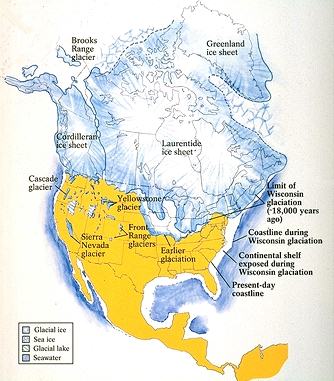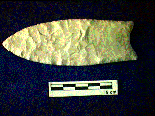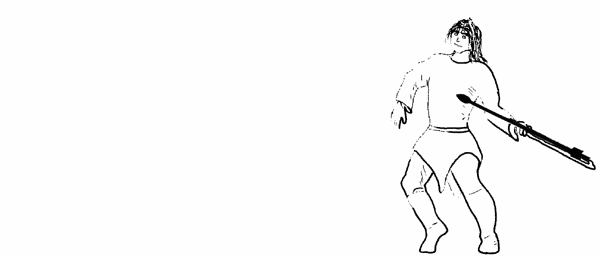
|
PREHISTORIC CULTURES OF NORTH AMERICA |
| S. Crouthamel, American Indian Studies/Anthropology, Palomar College |
III. Paleo-Indian Traditions
The origins of Native Americans, has been riddled with controversy from the time of first European colonization and the idea that 'America' was a 'New World'. This is based upon the fact that Europeans were not aware of the Americas in the times of classical Greek and Roman worlds. As Europeans expanded throughout the world, scientific development gained ground in the understanding of the peopling of all continents.
American Indian people saw themselves as the first humans on this continent. There were various mythical references such as 'Turtle Island'. American Indians (over 700 groups in North America) held to a variety of myths that included origins, migrations and different people or clans coming together. Some American Indians reject archaeological theory in terms of the where and how they came to be, while others see these theories as a work in progress with some truths. We will look at the current archaeological evidence for origins of the earliest Americans.
Only in the 20th century did irrefutable evidence come to light that demonstrated the presence of people on the American continent at the end of the last ice age with the discovery of kill sites of ancient Pleistocene mega fauna in the late 1920s-1930s. The human evidence has been sparse, and to date no human or hominid as been found in the Americas other than Homo sapiens sapiens. From linguistic evidence it is clear that Native Americans called Inuit, Yupik and Aleut are Paleo-Siberian (Eskimo-Aleut) and migrated 6-8,000 years ago from N.E. Asia after the last Ice Age (Glaciation). American Indian groups are more problematic and it is speculated that they came in 2-3 different waves and times between 40,000-14,000 years ago. American Indian language groups do not have clear links to other groups in the world. These groups are referred to as Paleo-Indian and came to the continent during or between the last series of Ice Ages (Glaciations).
First it is necessary to reconstruct the earth's climate during the last 100,000-150,000 years. Geological and geographical research has shown that the planet had experienced climatic shifts in mean temperature from 20-40 degrees F. based an a relative norm. The norm is roughly what we are in now and such warm periods referred to as interglacials. When the earth's temperature decreased the earth was in a glaciation or glacial advance...thus Ice Age. From about 1,800,000 to 10,000 years ago there were 7-10 glacial advances that were part of the Pleistocene Epoch during the Quaternary Period. When the mean temperature dropped 20 to 40 degrees F. the precipitation did not melt and was retained in the form of large continental glaciers expanding from polar caps and alpine glaciers expanding from mountain tops. Further, since the earth's water did not melt and run to the sea, the sea level lowered 75- 150 m (160-320 ft.), globally, exposing coastal and peninsular land masses. It is proposed that humans and animals occupied and /or moved over these newly exposed land masses. Also, these massive ice formations, glaciers, had considerable impact on modifying the earth's surface including the modification of river valleys and causing the formation of huge shallow lakes every time they receded during an warm interglacial period. In North America, Hudson's Bay, the Great Lakes and many other lakes were formed by such receding continental glaciers.
 |
The impact on humans during the past 100,000 years must have been dramatic due to the need to adapt to land mass changes, climate change and new ecosystems. Specific effects in North America included the multiple advances and retreats of two large continental glaciers, the Cordilleran in the western Canadian shield and the Laurentide in the eastern areas. Since no evidence for pre Homo sapiens sapiens and cultural artifacts exist before 20-30,000 years ago it is speculated that humans migrated from the 'Old World' to the "New World'. A land mass became exposed in the Bering Sea that was 1200 miles wide (called Beringia). It is postulated that humans and animals traveled over this land bridge and /or along it's exposed coastlines. However, the small number of sites and dating problems has made it difficult to provide a large enough sample for reliable evidence. Very little land mass remains uncompromised by glaciers over the last 50,000+ years. Over the last 20 -30 years archaeology has been plagued by pedantic/overly conservative archaeologists on one hand and over zealous archaeologists with a moronic press generating premature conclusions for a story. In some cases whole careers have been ruined by those that see questioning or challenging theories as a personal attack. In some ways the academia wars are somewhat parallel to recent American politics. The conservative elements effectively created a pre Clovis 'wall' that rejected the existence of any sites before 12,500 years ago. In the last few years enough pre-Clovis sites have gained enough validity to open up the possibility of human migration before the 12,500 years ago Clovis 'wall'. Further, new evidence has renewed theories of coastal migrations along the Pacific and Atlantic side from the north; since during the Pleistocene the central land route was blocked by huge continental glaciers. Current archaeological theories about migrations are as follows:
|
Pacific Coastal Route via the Aleutians and NW Coast |
20,000-15,000 years ago |
|
Beringia Land Bridge Theory via the Alaskan Peninsula into the Yukon |
40,000-14,000 years ago |
|
N. Atlantic Coastal (Solutrean Hypothesis) via Labrador |
24,000-18,000 years ago |
The Beringia Land Bridge Theory is the traditional theory but recent discoveries have led to possible coastal routes.that may have been used instead of or in addition to the Beringia idea that depended on continental glaciers opening up for passage into Canada. The who has also become more complicated with new genetic information. The linguistic and genetic evidence is pointing to at least 3-4 groups coming in subsequent waves as follows:
| 1. Small Stature American Indian Group (first to arrive going to South America) |
| 2. Larger Stature American Indian Group (Meso and North American groups) |
| 3. Dene American Indian Group (Subarctic groups some later migrating south) |
| 4. Paleo-Siberian/Eskimo-Aleut Group ( Arctic groups and last to arrive) |
The physical evidence and sites are now divided into the following:
|
Paleoindian: Pre- Clovis |
< 13,500 BP |
|
Paleoindian: Big Game Hunting; Clovis, etc. |
13,500-5,000 BP |
|
Archaic: Early Archaic |
10,900 BP |
Pre-Clovis
There has always been a handful of these very early sites (<13,500), with many having problems with stratigraphy and interpretation of dates. In some cases the presence of human activity and even artifacts (vs. naturefacts) has been problematic. Here are some current sites that most feel still warrant pre-Clovis status.
| NORTH AMERICA | Old Crow; Bluefish Caves; Swan Point Cactus Hill; Santa Rosa; Smith Creek Cave Meadowcroft, Topper, Paisley Cave |
| MESO AMERICA | El Cedral; Coxcatalan; Tequixquiac |
| SOUTH AMERICA | El Abra; Toca do Boqueirao; Toco do Pedra Furada; Santana do Riacho; Monte Verde; Piedra Museo |
These sites include evidence of a general hunting, fishing, and gathering (foraging) subsistence lifestyle with fire hearths, lithics (mostly small blades, flakes, some unfluted bifacials, cores), animal bone and some wood/fiber. Many of the sites occupied rock shelters, but some are in open areas near water.
Big-Game Hunting:
Clovis
At 11,050 RCYBP (radiocarbon years before present) or around 13,200
CYBP (carbon years before present) a definitive emphasis of big-game hunting with kill
sites and distinctive fluted projectile points swept through the entire
continent in a mere 500 +/- years. Whether this was a migration of new people or
a revolution of technological innovation is not clear, but it appeared and
spread very rapidly
throughout the continent. The emphasis of big-game hunting is a distortion due
to the nature of the preservation of kill sites involving large game. The people
hunted all sorts of game and did some foraging. The Clovis activities included
the killing of mammoths, mastodons, bison, camels, and giant ground sloth;
but also included deer, rodents and smaller game. In the big-game kill sites
the major innovation involved is highly specialized fluted projectile point
mounted on spear thrower or atlatl. These points were 3-9 inches in length and designed to penetrate the larger
Pleistocene megafauna. The atlatl gave increased leverage to launch a compound
dart such that once the fore-shaft went into the animal the fletched dart could be
recovered and reloaded. Recently a Clovis site, the Anzick Clovis Site near
Wilsall, Montana, has produced DNA results from a burial of a small boy (2 yrs
old). This site was discovered in 1968 and yielded Clovis points and even atlatl
fore-shafts. Only in 2014 with cooperation with Native American tribes was DNA
samples taken. The burial contained red ochre and the human remains were dated
10,800 RCYBP (12,894 CYBP) and indicate the boy was related to South America
groups and originated from Asian groups of the earlier origins not later
Canadian peoples who came later. This also refutes the N. Atlantic/ Solutrean
Hypothesis and supports the Pacific Coastal Theory.
These points were 3-9 inches in length and designed to penetrate the larger
Pleistocene megafauna. The atlatl gave increased leverage to launch a compound
dart such that once the fore-shaft went into the animal the fletched dart could be
recovered and reloaded. Recently a Clovis site, the Anzick Clovis Site near
Wilsall, Montana, has produced DNA results from a burial of a small boy (2 yrs
old). This site was discovered in 1968 and yielded Clovis points and even atlatl
fore-shafts. Only in 2014 with cooperation with Native American tribes was DNA
samples taken. The burial contained red ochre and the human remains were dated
10,800 RCYBP (12,894 CYBP) and indicate the boy was related to South America
groups and originated from Asian groups of the earlier origins not later
Canadian peoples who came later. This also refutes the N. Atlantic/ Solutrean
Hypothesis and supports the Pacific Coastal Theory.
 |
  |
The Pleistocene mega fauna that existed at the end of the Pleistocene Epoch became extinct with the huge elephantines first. These included the mammoth (a grazer) and the mastodon (a browser) with a variety of species throughout the continent and world.
Additional mega fauna included:
|
|
SITES: Naco, AZ; Site #1: Blackwater Draw; Murray Springs, AZ; Lehner Ranch,AZ
Folsom
By about 10,500 RCYBP the ancient bison became the primary game animal hunted and killed. The projectile points became smaller, but were still fluted. This big-game hunting tradition was limited to N. Mexico, the American Southwest and the Plains. In other areas the shift to exclusively smaller game and wild plant gathering (referred to as Archaic) began to take place.
 Bison
latifrons Bison
latifrons |
 Bison
antiquus Bison
antiquus |
SITES: Lindenmeier, CO; Hell Gap, WY; Folsom, NM
Plano
Around 8,000 RCYBC the innovation of knapping a flute on these atlatl points disappeared and Pleistocene megafauna became extinct in most areas. Some emphasis of big-game hunting persisted on the North American Plains where bison survived and evolved into a smaller modern form. These cultures are generally referred to as Plano with specific lithic traditions/ points like Eden, Scottsbluff, Cody, etc. The projectile points were long bifacials that were pressure flaked/knapped, but without the fluting like seen in the Clovis and Folsom bifacials. Again, in other areas the Archaic tradition continued to replace big-game hunting.
 Bison
bison Bison
bison |
SITES: Eden, WY; Scotts Bluff, NE; Head-Smashed-In, Alberta, Canada
Archaic
From 13,500 BP to 8,500 BP the entire continent became increasingly arid, humans became increasingly more efficient at hunting the big game, and populations of humans slowly increased. Actually, this is a world wide phenomenon. These factors brought about a world wide extinction of 'Ice Age' mammals and in America it is referred to as Pleistocene Extinction. The outcome was that humans did not become extinct, but changed their hunting and gathering (H&G) or foraging patterns to emphasize smaller game and wild plant gathering. Certain special variations arose along lakes, rivers or sea coasts. In general these changes are referred to as the Archaic tradition and began to happen as early as 10,900 BP and finally in the North American Plains about 5,000 BP. Projectile points became smaller and stemmed, but were still used on atlatl darts (we do not know when or where the bow and arrow was invented/ possibly 3- 5,000 BP) . However, grinding implements like the mano/metate and pestle/mortar were increasingly present in the Archaic along with polished stone, bone and a greater variety tools.
For the rest of the course we will go to each of the North American culture areas and basically begin with the Archaic and follow subsequent culture changes to the time of contact with Europeans, e.g. 9,000 to 500 years ago. In some of these culture geographic areas the Native Americans refined or modified the Archaic H&G traditions, but in some areas the people adopted some form of CBS (Corn (maize), Beans, Squash) based horticulture/agriculture.
Next Lecture: IV. Plains
Links:
Center For The Study of First Americans
Pleistocene Megafauna Extinction
Copyright © S. J. Crouthamel 2013